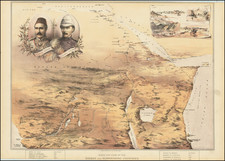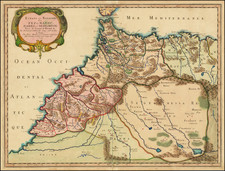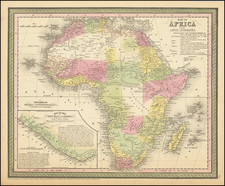Early Maps Tracing The Supposed Sources of the Nile
Rare set of 3 maps on a single sheet, providing a study of the various theories of the source of the Nile River.
The first map shows the information derived from observations made by the Portuguese explorer Duarte Lopes between 1578 and 1584.
The second map shows information derived from early Arab cartographic sources.
The third map (oriented with south at the top) shows the information derived from the Spanish Jesuit missionary Pedro Paez, between 1618 and 1621, derived primarily from his História da Ethiópia, which would not be published in a printed edition until 1905-1917. Paez is credited with the discovery of the source of the Blue Nile River in the mountains of Ethiopia (Lake Tana). Paez reported that there were two "fountains" there.
The map is quite rare on the market. AMPR lists two copies offered in 1985 and 1994.
Athanasius Kircher (1601-1680) was a Jesuit priest and a well-respected scholar known for his role in disseminating knowledge. Kircher was educated in Greek, Hebrew, and the humanities at Fulda, Paderborn, Cologne, Koblenz, and Mainz. After fleeing the Thirty Years’ War in Germany, Kircher worked as an academic at Avignon and, from 1634, Rome.
In Rome, Kircher served as an intellectual node, spreading information sent from around the world by Jesuit missionaries. Particular interests included ancient Egypt, astronomy, mathematics, medicine, music, and languages (both ancient and modern). He also made several maps and was a geographic compiler. It is likely he was the first person to depict the Pacific Ring of Fire on a map.
Kircher combined a mixture of hermeticism with nascent scientific inquiry, gaining him a reputation as one of the final Renaissance men. For example, he observed the eruptions of Etna and Stromboli. He had himself lowered into the crater of Vesuvius soon after an eruption to observe the changes wrought by the cataclysm. He experimented with bioluminescence by seeking the applications of firefly extract as a light source. He also made the first known Aeolian harp.
Kircher wrote 44 books, while over 2,000 of his manuscripts and letters survive. He also assembled one of the first natural history collections, the Museo Kircheriano or the Kircherianum, which was broken up after his death and became the foundation of several institutional collections.











![Colton's Africa [Southern Sheet]](https://storage.googleapis.com/raremaps/img/small/98349.jpg)
![[ Morocco ] Statuum Maroccanorum, Regnorum nempe Fessani, Maroccani, Tafiletanin et Segelomessani Secundum suas Provincias accurate divisorum, Typus generalis novus . . . 1728](https://storage.googleapis.com/raremaps/img/small/95640.jpg)

![[The Siege of Peñón de Vélez de la Gomera in 1564] El Pignon / Il vero & natural sito della Villa di Velez de Gomera, & l'inespugnabile forte et castello chiamato il Pignon, situato in Africa di Barbaria, a l'incontro d'Ispagna, newl qual luogo Solemano li Mori, et Corsari di mare . . .](https://storage.googleapis.com/raremaps/img/small/75226.jpg)